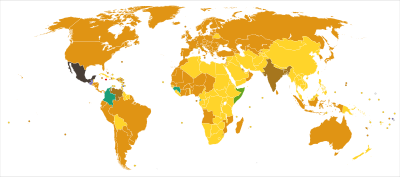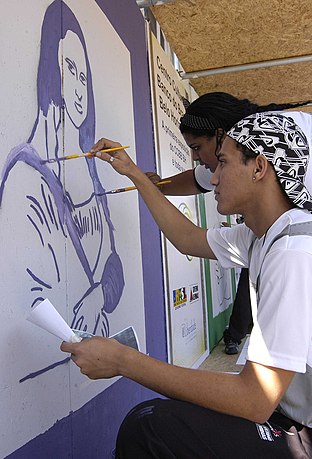Вікісховішча:Правілы аўтарскага права
Files uploaded to Commons should be free both in the country of origin (as defined by the Berne Convention) and in the United States of America, and possibly in other countries involved, either through being properly licensed by the copyright owner or being in the public domain.
Правілы аўтарскага права паводле прадмета
- Main page: Вікісховішча:Аўтарскія правы паводле прадметаў.
Вікісховішча:Аўтарскія правы паводле прадметаў brings together a variety of subjects and aims to answer the question "Can I upload photographs/pictures of ...?"
Прымальна запампоўваць:
- Generally, photos you have taken yourself of uncopyrightable subjects such as views; nature; yourself; and people who have given their consent for you to photograph them and for you to publish the photograph. (However, you should remember that uploads should be educational - Commons is not your private web space.)
- Photos taken by you, or scans or photocopies made by you of objects or designs whose copyright has expired (usually 70 years after the death of the author, but see Commons:Copyright rules by territory for a country-by-country list).
- Mere mechanical scans or photocopies, made by somebody else, of an object or design old enough to be in the public domain (usually 70 years after the death of the author, but see Commons:Copyright rules by territory for a country-by-country list). For scans of old images that may have been enhanced, see Вікісховішча:Калі карыстацца шаблёнам «PD-scan».
- Photographs, taken either by yourself or someone else, that are faithful reproductions of 2D public domain works of art. See Вікісховішча:Калі карыстацца шаблёнам «PD-Art».
Other subjects may or may not be allowable - see headings at Вікісховішча:Аўтарскія правы паводле прадметаў. If you want to have an answer to the question "Can I upload photographs/pictures from ...?", see the section at Вікісховішча:Аўтарскія правы паводле прадметаў on Internet images. See also: Commons:Threshold of originality.
Просты праверачны сьпіс
Let's assume you took a picture with your camera, or you've scanned it from somewhere, or you've downloaded it off a web server - and want to upload it to Wikimedia Commons. How do you know what's OK and what's not? Here's a simple chart that helps you decide. In cases of doubt, read the further advice for your country first. If you still don't know for sure, ask on Commons:Help desk or Commons:Village pump in your local language.
See Вікісховішча:Аўтарскія правы паводле прадметаў for a more complete list.
 Прымальна
Прымальна
Your own photos of:
- Nature (forest, sky, etc.)
- Animals (cats, dogs, etc.)
- Insects (ants, beetles, etc.)
- Produce (apples, tomatoes, etc.)
- People who have given their consent for their image to be published
- You (as long as you don't use this as your private webspace), but not pictures others took of you (these require the consent from whoever took the picture)
- Objects that are public domain by age both in the United States and your jurisdiction:
- Buildings built by an architect who died 70+ (preferably 100+) years ago
- Works of art created by an artist who died 70+ (preferably 100+) years ago and first published before 1928
- Books by authors who died 70+ (preferably 100+) years ago and first published before 1928
- Newspapers and Magazines published by an author who died 70+ (preferably 100+) years ago and first published before 1928
Own scans of:
- Material where copyright has expired in both your jurisdiction and the United States.
- Pictures created entirely by you (based either on no earlier source or on a source which is in the public domain)
Material from web servers:
- Material where copyright has expired in your jurisdiction, the United States and the jurisdiction of the web server.
Сумнеўна
All kinds of copyrighted material, when uploader does not own the copyright:
- Logos. Only very simple designs are OK, see Вікісховішча:Дазволы section on Simple design.
- Screenshots. See Commons:Screenshots.
Photographs, drawings, scans and other reproductions of:
- Cars (cars with only one color and without any ads, paintings etc. are OK)
- Products of daily use (utilitarian designs are OK)
- Book covers (only very simple designs are OK)
- Currency (depends on country law; please see Commons:Currency)
- Stamps (depends on country law; please see Commons:Stamps)
- Buildings built by an architect who died less than 70 years ago or is still alive. See Commons:Freedom of panorama.
- Permanently installed works of art in a public place, created by an artist who died less than 70 years ago or is still alive. See Commons:Freedom of panorama.
- Interiors of private houses, homes, museums.
- Celebrities. See Вікісховішча:Фатаграфіі вызначаных людзей.
- Normal people who have not given their consent. See Вікісховішча:Фатаграфіі вызначаных людзей.
 Непрымальна
Непрымальна
- Fair use images. See Вікісховішча:Сумленнае выкарыстаньне.
- Fan art that closely resembles copyrighted material. See Вікісховішча:Заўзятарскае мастацтва.
- Reproductions of objects that are copyrighted by someone other than you, like the following:
- Action figures, statuettes and other copyrighted material. See Вікісховішча:Вытворныя працы.
- Album, videogame, movie and other commercial products covers, posters, newspapers and magazines whose copyright has not expired (covers and interiors).
- Sounds of things that are copyrighted by someone other than you, like the following:
- Copyrighted radio stations (programs and commercials)
- Lyric songs created by an author whose copyright has not expired
Правілы аўтарскага права паводле тэрыторыі
- Main page: Commons:Copyright rules by territory.

Laws about copyright differ from country to country. Images uploaded to Commons, unless uploaded from the United States, involve the interaction of two or more copyright jurisdictions. The laws of individual countries differ especially in the following points:
- The time for which a copyright applies. In most countries, copyright expires no later than 70 years after the death of the author (p.m.a.). There may be special terms for recently published old material.
- Status of works of the government. In many (but not all) countries, documents published by the government for official use are in the public domain.
- Material applicable for copyright. In some jurisdictions, pictures of artistic work like architecture, sculptures, clothing etc. can not be used freely without the consent of the creator of the original artwork.
Almost all countries in the world are party to the Berne Convention for the Protection of Literary and Artistic Works (see here for the text). Following this convention, countries enforce copyrights from other countries, according to certain rules. One consequence of these rules is that we should always care about the laws of the country of origin of the work.
Стаўленьне да няпэўнасьці
Калі дата невядомая

Assume the most recent possible date considering the subject. The photo here shows Albert Einstein and his wife Elsa. Elsa died on December 20, 1936; Albert later on April 18, 1955. Therefore, it was taken before December 20, 1936.
Калі месца невядомае
Assume the most restrictive reasonably possible location considering the subject. In the Einstein photo here, it could be the United States, Germany, the Atlantic Ocean (assuming the Einstein couple was on board a ship) or any other country or location he reasonably could have gotten a photo taken in, but it would not likely be Nepal, for example.
Калі фатограф невядомы
Assume the most reasonable restrictive copyright barring evidence to the contrary. That is, unless the site or source itself asserts a freer set of rights (and you have good reason to believe they are not misapplying rights they do not have) assume the photographer retained all rights he legally could in his jurisdiction.
But the Berne Convention says that photographs are in the public domain 50 years after publication if the photographer is unknown. This applies unless a country has made a specific law.
Generally, for countries with copyright terms based on the death of the author, community consensus has found that it is safe to assume that the author died no more than 50 years after creating the work in cases where the author is unknown. This is encapsulated in the template {{PD-old-assumed}}.
Прыклад

Assume that the author of the image on the right is unknown to us, but not unknown in the copyright sense. We know that the image represents the ship Borda, which was scrapped in 1891. The image could have been taken that year by a 20-year-old man, who could die of old age in his 90s; this brings us to 1960. Assuming the normal terms for "works" apply and a 70-year long copyright term pma, the image would be covered by copyright until the 2030s. If the work was truly anonymous, then the copyright probably did not exceed 1891 + 70 = 1961, which means it is free if it was published before 1928 (or free in USA for other reasons).
Caution, not being able to find an author does not mean that the work is anonymous. It can mean that we did not search long enough or at the right place.
Глядзі таксама: Вікісховішча:Ахоп праекту/Засьцерагальны прынцып.
Глядзіце таксама
- Commons:Wikilivres – a similar site which is not operated by the Wikimedia Foundation but which allows for material in the Canadian public domain which is less restrictive than the United States
- Пашукайце сярод частых пытаньняў.
- Калі вы напішаце
{{helpme}}на сваёй старонцы абмеркаваньняў, з вамі пры першай жа магчымасьці зьвяжацца добраахвотнік! - Далучайцеся да IRC-каналу #wikimedia-commons дзеля размовы ў жывым этэры. Ня чулі пра IRC? Націсьніце тут, каб злучыцца імгненна!
- Наведайце старонку дапамогі Вікісховішча.


